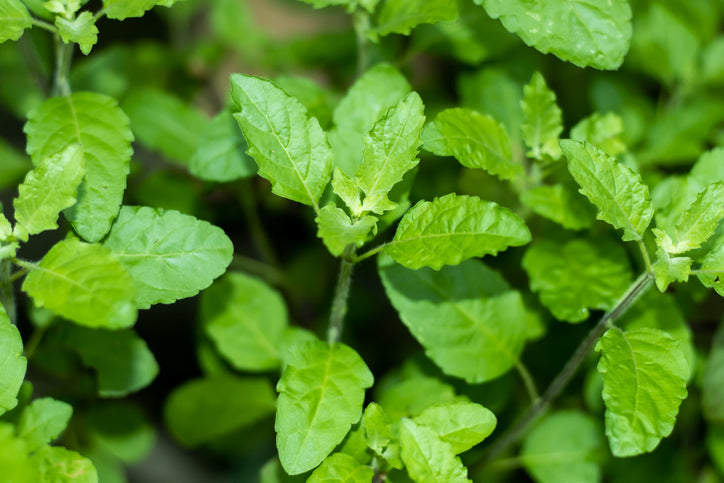
The Tulsi Adaptogen: Where the Sacred Meets Science
Perhaps the only adaptogen more integral to Indian Ayurveda than ashwagandha is holy basil. With a probable history spanning 6 millennia of Ayurvedic medicine, the adaptogen holy basil is actually embedded in Hinduism itself, where it was originally called tulsi.
Tulsi, in the Vedic Bhagavata Purana, a 9th century sacred Hindu text, is referred to as the “queen of herbs,” and is perceived as the plant incarnation of Vishnu’s wife, Lakshmi, the goddess of abundance, love and prosperity.
Holy basil was seen as a gateway between the mortal and the divine, and was utilized across many cultures for thousands of years, representing purity and treating a variety maladies. When the Christians got ahold of it, they started using it in rituals and renamed it holy basil… because it smells like basil.
Brilliant work, guys.
Holy Basil: A Revered Bioactive Plant in Folk Medicine
This adaptogenic subshrub native to India and Nepal is one of those rare bioactive plants where all parts can be used to reap its benefits, and more importantly, are safe to consume in all forms. Like castor, where the pressed oil is awesome for a bunch of things but the raw seeds will kill you, many other medicinal plants are equal parts useful and poisonous.
For instance, another plant used for medicinal purposes in Ayurvedic and Central American folk medicine is Agave sisalana. The heart and seeds of this plant are edible and highly-nutritious. The sap is used as a binder for herbal tonics and poultices and used to treat GI issues, as it has remarkable antiseptic and disinfectant properties. However, when not prepared or applied just so, the sap can cause skin, mouth and throat sores just through contact, and can even cause bone granulomas if a leaf punctures the skin near a bone.
Hate to have been the guy who figured that out.
But back to holy basil, which will not give you a weird form of leprosy if you touch it wrong. Traditional uses include:
- Using the whole plant to treat nausea and vomiting
- Using essential oil extract from the leaves for bug bites
- Creating an ointment with oil extract to treat eczema
- Consuming the fresh flowers to treat bronchitis
- Using an alcohol extract for diseases of the eye as well as stomache ulcers
- Mixing the seeds with black pepper for malaria
In Hindu cultures, tulsi is cultivated at temples and incorporated into several aspects of religious life. Simply taking care of holy basil plants at home is considered an act of worship. It is also incorporated in yearly festivals, in cuisine and, of course, in all those (plus more) traditional medicines. So – what is so cool about holy basil that it’s actually considered holy?
What We Know About How Holy Basil Works in the Body
Get ready for this, because it’s pretty cool. Unlike other adaptogen tonics with ashwagandha and Siberian ginseng, we actually understand many of the mechanisms by which holy basil teas and poultices acts on the body. You’ll hear other adaptogens’ abilities referred to as occurring by a “non-specific mechanism,” but thankfully the phytochemicals in holy basil aren’t playing hard to get:
- Carvacrol offer a wide range of health benefits and is found in many common herbs, including thyme and oregano. It has high antimicrobial activity, as well as antioxidant and anticancer properties. In fact, preclinical trials have demonstrated these anticancer properties in breast, liver and lung carcinomas.
- Eugenol, most commonly found in as clove oil, is a jack of all trades, used in foot, cosmetics, pharmaceuticals, insecticides, and more. Despite its insecticide properties, it’s safe to consume, and has analgesic, antiseptic, anticancer and anti-inflammatory effects on the body.
- Linalool is a terpene also found in the cannabis plant that has mood-boosting and stress-reducing properties.
- Oleanolic acid is a powerhouse in itself. A triterpenoid that exhibits protective properties for the liver, it has antiviral, antibacterial, anti-diabetic, antitumour/anticancer, antiparasitic, and even more properties related to its powerful anti-inflammatory potential.
- Rosmarinic acid has long been used in traditional pharmacologies for anxiety, stomache problems, digestive conditions, and has even been used to treat medication-resistant viral lesions.
- Ursolic acid is widely regarded as an antioxidant that is both antibacterial and antifungal. It has also shown evidence of protecting the liver, DNA integrity, muscle atrophy, and has shown mood-supporting abilities.
- β-caryophyllene is an anti-inflammatory compound that doesn’t have steroidal properties. It can act as an analgesic and a fever reducer.
On top of all that, holy basil is also considered a superfood, because it’s jam-packed with nutrients that are often hard to get enough of in our daily diets:
- Calcium
- Fiber
- Iron
- Magnesium
- Manganese
- Potassium
- Protein
- Vitamin A
- Vitamin B6
- Vitamin C
- Vitamin D
- Vitamin K
- Zinc
Kind of starting to wonder what drinking a little holy basil tonic every day can’t do for your health…
Clinical Evidence for the Efficacy of Holy Basil as an Adaptogen Supplement
Okay, so it all looks good on paper, but where’s the proof? We need some meat to support the bones of all these claims. Unlike most other adaptogens, there’s a pretty decent body of clinical data on holy basil’s abilities… probably because it has so many.
Most of the clinical data we have on holy basil as an adaptogen comes from rat, rabbit and in vitro studies, which aren’t always easy to talk about, especially when purposefully-applied stressors are involved. Don’t worry; we’ve got some human trials in there, too. Here are some highlights that explore holy basil’s adaptogenic and pharmaceutical uses in humans:
- A 2008 study on the potential of holy basil as a complementary therapy for chronic challenges with stress reactivity used 35 subjects diagnosed with GAD. Subjects took a fixed dose 2x daily for 60 days. This course of treatment resulted in statistically significant drops in heightened reactivity, associated stress and correlated low mood. At the same time, it improved attention and willingness to adapt at a statistically significant level.
- A 2009 review of the academic literature on holy basil’s therapeutic effects shows support for the claims that holy basil is adaptogenic, antimicrobial, antidiabetic, anti-inflammatory, anti-carcinogenic, and radioprotective. It also supports its potential as an immunomodulatory and as a protective compound for the liver, heart and nervous system.
- A 2017 literature review on human holy basil trials found that clinical studies support traditional uses, suggesting holy basil may effectively treat chronic ailments like metabolic syndrome, diabetes and psychological effects of stress.
- A 2022 study on the adaptogenic abilities of holy basil looked at its effects on mood, recovery and stress levels in adults under stress. This was a placebo-controlled, double-blind study performed on 100 volunteers. After 8 weeks of a daily 125mg dose of holy basil, participants in the experimental group showed:
- Mood improvements
- Reduced sleep problems
- Lower biological indicators of stress
- Lower subjective stress ratings
- Lower diastolic and systolic blood pressure
- Buffered stress response
Limitations on the Clinical Understanding of the Tulsi Plant
Okay, so we’re obviously excited about holy basil because, well – did you read the article? But we’ve gotta touch the ground at some point. The reality is, we live in a society where anecdotes and organic real-life use doesn’t add up to safety and validity; for Western medicine to truly incorporate (and finally take full advantage of!) holy basil and all its other adaptogen friends, it wants hard facts in huge numbers. We get it; it’s about safety.
Cautions we need to remember as we move forward with research on holy basil include:
- There is no clinical data on holy basil’s safety for a course of more than 8 weeks/60 days.
- Holy basil may not be right for people who are pregnant or trying to get pregnant; some animal studies have shown holy basil may reduce implantation ability and the chance of a pregnancy reaching full-term.
- There is no data on whether it’s safe to take holy basil while lactating.
- Since it may act as a thyroid activity suppressant, it may not be the right adaptogen for people with hypothyroidism.
- Holy basil may not be safe to take with blood thinners, as it already has an anti-coagulant effect.
- Because it may help regulate blood sugar, tulsi should probably not be taken along with glucose-lowering drugs like insulin.
Like any bioactive medicine, plant, chemical – literally anything that can affect your body in any way, it’s always a good idea to do your research first. Traditional folk medicines are sure about this crazy-useful superfood-adaptogen chimera; that’s for sure. Unfortunately, clinical use just isn’t there yet. But since holy basil does have such potential, it wouldn’t hurt to incorporate it into your daily morning superfood drink in the meantime. Just saying.



